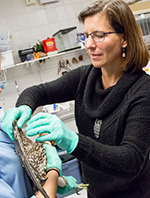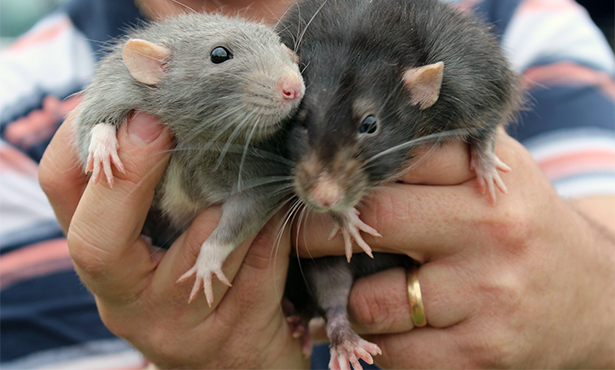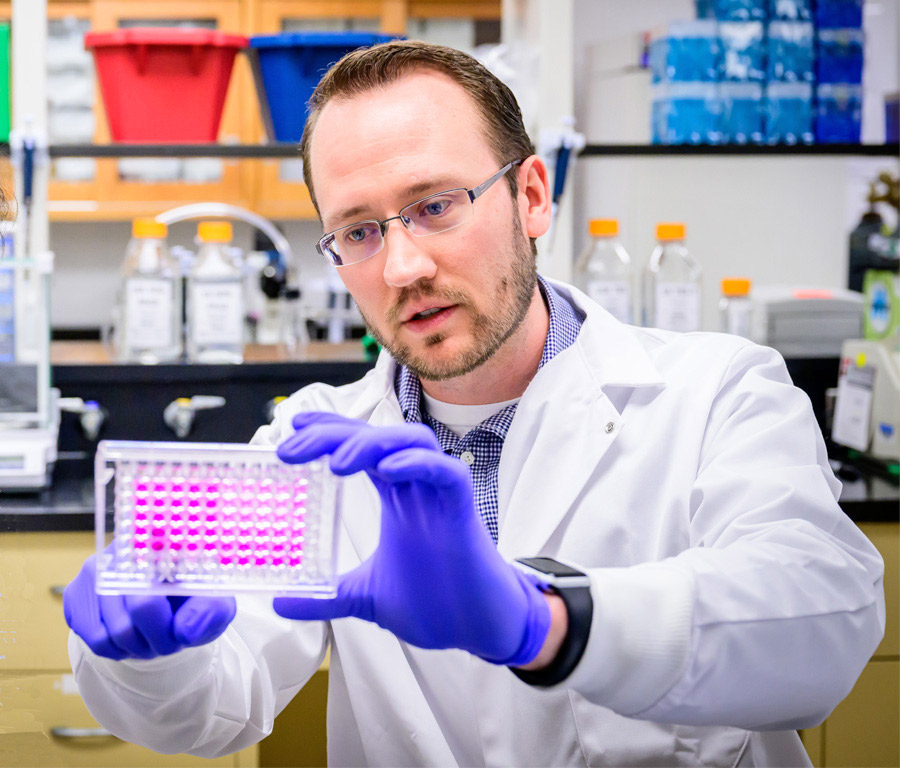[row]
[column size=”6″]
“An exotics veterinarian, a public health veterinarian, and a veterinary epidemiologist walk into a rattery….”
It may sound like the setup for a very odd joke, but this is exactly what’s been happening in Illinois recently, as local, state, and federal health agencies respond to several human cases of Seoul virus transmitted by rats.
The Centers for Disease Control and Prevention (CDC) and the Illinois Department of Public Health (IDPH) have been investigating at least 10 human cases in Wisconsin and Illinois of exposure to Seoul virus, a strain of hantavirus that may cause mild illness and has the potential to cause severe kidney problems (but is distinct from a more lethal hantavirus strain that causes respiratory disease). At two Illinois rat-breeding facilities—called ratteries—rats and people tested positive for the virus in January. Before the discovery of the infection, rats from these facilities had been shipped to 12 other states, where investigations into possible spread of the virus are still under way.
Unfortunately, this story has no simple punch line. But there is one positive aspect to the ongoing investigation: It provides an opportunity to raise awareness about the ways that human, animal, and environmental health are inextricably linked.
On January 30, we talked with two College of Veterinary Medicine faculty members who have assisted in the investigation to learn more.
[/column] [column size=”6″]
About Our Experts |
|
 Dr. Yvette Johnson-Walker is involved in infectious disease outbreak investigations and conducts training for emergency response preparedness for zoos and other animal exhibitor institutions. She serves on the steering committee for the college’s Center for One Health Illinois and is a member of the University’s Infectious Disease Working Group. |
 Dr. Julia Whittington provides veterinary care for exotic pets, including birds, reptiles, and rats and other small mammals, at the Veterinary Teaching Hospital. For more than 15 years she has served as the medical director of the college’s Wildlife Medical Clinic. She chairs the college’s biosecurity committee. |
[/column][/row]
[toggleset]
[toggle]
How many people have pet rats?
Dr. Whittington: According to statistics from the American Veterinary Medical Association, in 2012 nearly 400,000 U.S. households had pet rats or pet mice, with a total of about 868,000 of these little pets nationwide. A more recent estimate is that more than half a million U.S. households have at least one pet mouse or rat.
[/toggle]
[toggle]
These Seoul virus cases impact a very small segment of the population. Why is this newsworthy?
Dr. Whittington: This is the first time cases of Seoul virus have been linked to pet rats, as opposed to wild rats, in the United States.
It turns out that pet rats and rats used in biomedical research have been bred from the brown rat, which is one of two rat species that serve as the natural reservoir for Seoul virus. Brown rats provide the long-term host for the virus but, as is often the case with the reservoir species, are not sickened by it. So the owners of pet rats had no reason to suspect their rats were carrying a virus.
We have almost no data regarding how widespread the Seoul virus may be among pet rats. One national veterinary diagnostic laboratory that includes a test for Seoul virus in a routine health panel for pet rats reported having identified no cases among samples received over the past several years; that particular diagnostic test is currently being evaluated by the CDC to ensure its validity.
It is reassuring to note that Seoul virus is not spread person to person, and no human cases have previously been connected to pet rats.
[/toggle]
[toggle]
How does this situation compare with other cases of disease spread by pets?
Dr. Whittington: In 2003, infected animals newly arrived from Ghana for the pet trade were housed near prairie dogs at an Illinois pet store. These prairie dogs then transmitted monkeypox to nearly 50 people in six states.
In the monkeypox case and in the Seoul virus situation, there was co-mingling of animals from different sources. The current investigation has revealed that within the pet rat industry there is an incredible amount of movement of animals. Breeders exchange animals to achieve specific traits, such as a certain coat color. There are also rat swaps among owners.
Dr. Johnson-Walker: Pets may be implicated in many “zoonotic” diseases, meaning diseases that can be transmitted from animals to people. Here in Champaign County there have been cases of tularemia, which is found in rabbits and rodents. Outdoor cats that hunt wildlife provide one avenue for that disease to reach humans.
Leptospirosis is another bacterial disease transmitted by animals, most commonly cattle, pigs, dogs, and rodents. Pet dogs can be infected by contact with wildlife or contaminated lakes and streams, and can then pass the disease to the people they live with.
The bottom line is: Pets are part of our families. Whatever the pet has, the family may have, and vice versa. That’s one of many reasons it’s important to practice safe handling of animals, whether pet rat, dog, or parrot. It’s safest not to exchange kisses with pets, to keep your food away from pet areas, and to avoid coming into direct contact with pet waste.
Ensuring regular veterinary care for your pets will also help prevent disease transmission to human family members. Your veterinarian is one of the best sources of information about zoonotic diseases.
As an epidemiologist, I’d love to see MDs expand the scope of their questions when taking a patient’s history. They routinely ask people, “Do you smoke?” But how often do they ask about pets in the household, and whether the pets are getting annual health checks?
[/toggle]
[toggle]
How have experts from the college aided the Seoul virus investigation?
Dr. Johnson-Walker: College personnel have tested rats, humanely euthanized pets exposed to the virus, advised on biosecurity protocols and a statewide response plan, and prepared information about the virus for veterinarians and pet owners.
As someone trained to facilitate emergency response planning, I’m taking the lead in coordinating the college’s collaborations with IDPH and CDC.
Dr. Whittington: Our breadth and depth of knowledge about animals and zoonotic disease far exceeds what any single public health agency can provide.
As a clinician who sees exotic pets nearly every day, I understood some of the obstacles that would be encountered in trying to draw blood from dozens of rats in a single day when testing for the virus at suspected ratteries. When the instructions I had been given didn’t work—it was not possible to get a sufficient blood sample from the rats’ tails—I was prepared with “plan B,” in this case, an anesthesia machine that allowed me to safely draw blood from the submandibular vein.
Veterinarians are like MacGyver. We have a lot of experience thinking on our feet and finding solutions.
[/toggle]
[toggle]
What are some lessons to be learned from the rat virus situation?
Dr. Johnson-Walker: For poultry, pigs, and other food animals, farms follow the highest biosecurity measures to prevent the introduction of disease agents into the animal population. The movement of animals is highly regulated in the event that disease occurs and its origin must be traced.
For pets, this is not the case. Dogs congregate at pet stores, parks, groomers…. The outbreak of the new strain of canine flu two years ago showed how rapidly pathogens can spread.
It’s really no different from the scenario in which one person with a highly transmissible disease, like Ebola, travels by plane to another country. Anyone who comes into contact with that person can be infected and become a source of infection to others. This is why you are asked at every doctor’s visit if you’ve recently visited a country that has Ebola virus.
I think the Seoul virus cases can bring home to everyone, whether rat owner or not, that common sense precautions should always be followed to limit disease spread. Wash your hands!
Dr. Whittington: The cases of Seoul virus provide a perfect example of the blurred interface between domestic and wild animals.
Half a mile from the vet school, there’s a new medical facility with a lovely water feature. Every time I drive by I think, soon there will be complaints about geese taking advantage of the water—“if you build it, they will come”—and the geese will likely enjoy snacking on the cattle feed at the beef farm directly across Windsor Road. Then they’ll fly back to the water feature, bringing any bugs encountered on the farm to the grass and parking lot shared by people.
If we want to live with animals—which we do!—and we want to continue to urbanize the landscape where the animals live, and we want to have a global economy, then we also have to realize that diseases are going to travel too, between countries and between species.
The key is for public health experts, medical doctors, and veterinarians to work together to find ways to reduce health risks introduced by human activity.
[/toggle]
[/toggleset]
Feature image from Pixabay.




